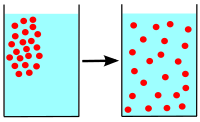
Photo from wikipedia
The depletion of fossil fuels and stringent emission regulations have encouraged the development of renewable fuels, especially biodiesel and alcohols fuels. The aim of the investigation is to explore the… Click to show full abstract
The depletion of fossil fuels and stringent emission regulations have encouraged the development of renewable fuels, especially biodiesel and alcohols fuels. The aim of the investigation is to explore the spray diffusion characteristics at different biodiesel-butanol blended ratios (0, 10%, 30%, and 50%), ambient temperatures (600 K, 700K, and 800 K), and pressures (1 MPa, 3 MPa, and 5 MPa). The experiment was carried out in a constant volume combustion chamber. The liquid- and vapor-phase spray images were captured by backlight illumination and schlieren imaging technique, respectively. The axial, radial, and spatial diffusion characteristics were analyzed, including spray penetration, cone angle, area, R-parameter, and perimeter ratio. Results show that in the case of biodiesel mixed with 10% n-butanol, for liquid-phase spray, the liquid-core spray with high concentration has the largest impact on axial diffusion, and for vapor-phase spray, axial dispersion is slower and radial diffusion is faster. The fuel density and ambient temperature have a more significant impact on the liquid-phase axial dispersion at the steady state compared with ambient pressure and injection pressure. At lower ambient pressures, increasing the injection pressure can accelerate the radial diffusion and increase the spray cone angle, which is opposite of the variation law at higher ambient pressures. The radial spray has a faster diffusion with adding a small or middle proportion of n-butanol, and the maximum values of liquid- and vapor-phase cone angles appear at biodiesel blended with 30% and 10% n-butanol, respectively. Moreover, the axial diffusion plays a dominant role in the spray spatial dispersion.
Journal Title: Proceedings of the Institution of Mechanical Engineers, Part A: Journal of Power and Energy
Year Published: 2022
Link to full text (if available)
Share on Social Media: Sign Up to like & get
recommendations!